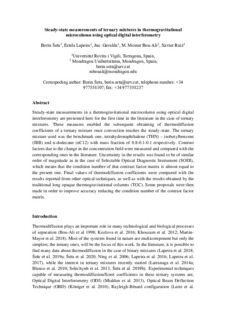Izenburua
Steady-state Measurements of Ternary Mixtures in Thermogravitational Microcolumn Using Optical Digital InterferometryArgitalpen data
2021Bertsioa
PostprintaDokumentu-mota
ArtikuluaArtikuluaHizkuntza
IngelesaEskubideak
© The Author(s), under exclusive licence to Springer Nature B.V. part of Springer Nature 2021Sarbidea
Sarbide bahituaBahituraren amaiera data
2022-02-28Argitaratzailearen bertsioa
https://doi.org/10.1007/s12217-020-09861-5Non argitaratua
Microgravity Science and Technology. Vol.3. N. artículo 18, 2021Argitaratzailea
Springer Nature B.V.Gako-hitzak
Thermodiffusion
Ternary mixtures
Steady-state analysis
Two colour lasers ... [+]
Ternary mixtures
Steady-state analysis
Two colour lasers ... [+]
Thermodiffusion
Ternary mixtures
Steady-state analysis
Two colour lasers
Thermogravitational microcolumn [-]
Ternary mixtures
Steady-state analysis
Two colour lasers
Thermogravitational microcolumn [-]
Laburpena
Steady-state measurements in a thermogravitational microcolumn using optical digital interferometry are presented here for the first time in the literature in the case of ternary mixtures. These measu ... [+]
Steady-state measurements in a thermogravitational microcolumn using optical digital interferometry are presented here for the first time in the literature in the case of ternary mixtures. These measurements enabled the subsequent obtaining of thermodiffusion coefficients of a ternary mixture once convection reaches the steady-state. The ternary mixture used was the benchmark one, tetrahydronaphthalene (THN) – isobutylbenzene (IBB) and n-dodecane (nC12) with mass fraction of 0.8-0.1-0.1 respectively. Contrast factors due to the change in the concentration field were measured and compared with the corresponding ones in the literature. Uncertainty in the results was found to be of similar order of magnitude as in the case of Selectable Optical Diagnostic Instrument (SODI), which means that the condition number of that contrast factor matrix is almost equal to the present one. Final values of thermodiffusion coefficients were compared with the results reported from other optical techniques, as well as with the results obtained by the traditional long opaque thermogravitational columns (TGC). Some proposals were then made in order to improve accuracy reducing the condition number of the contrast factor matrix. [-]





















